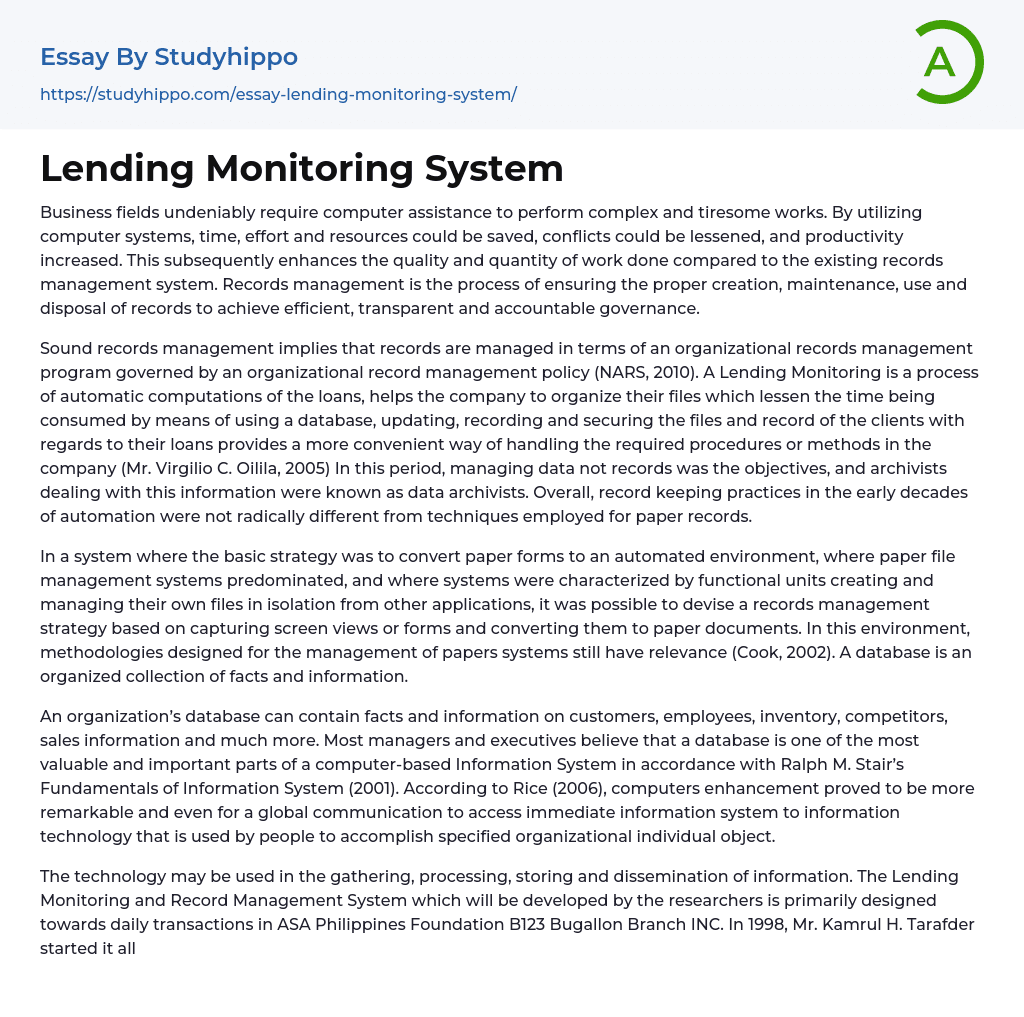Sound records management implies that records are managed in terms of an organizational records management program governed by an organizational record management policy (NARS, 2010). A Lending Monitoring is a process of automatic computations of the loans, helps the company to organize their files which lessen the time being consumed by means of using a database, updating, recording and securing the files a
...nd record of the clients with regards to their loans provides a more convenient way of handling the required procedures or methods in the company (Mr. Virgilio C. Oilila, 2005) In this period, managing data not records was the objectives, and archivists dealing with this information were known as data archivists. Overall, record keeping practices in the early decades of automation were not radically different from techniques employed for paper records.
In a system where the basic strategy was to convert paper forms to an automated environment, where paper file management systems predominated, and where systems were characterized by functional units creating and managing their own files in isolation from other applications, it was possible to devise a records management strategy based on capturing screen views or forms and converting them to paper documents. In this environment, methodologies designed for the management of papers system
still have relevance (Cook, 2002). A database is an organized collection of facts and information.
An organization’s database can contain facts and information on customers, employees, inventory, competitors, sales information and much more. Most managers and executives believe that a database is one of the most valuable and important parts of a computer-based Information System in accordance with Ralph M. Stair’s Fundamentals of Information System (2001). According to Rice (2006), computers enhancement proved to be more remarkable and even for a global communication to access immediate information system to information technology that is used by people to accomplish specified organizational individual object.
The technology may be used in the gathering, processing, storing and dissemination of information. The Lending Monitoring and Record Management System which will be developed by the researchers is primarily designed towards daily transactions in ASA Philippines Foundation B123 Bugallon Branch INC. In 1998, Mr. Kamrul H. Tarafder started it all in ASA Bangladesh. It is a non-profit organization devoted to increasing family incomes and saving while giving the people greater access to life support goods and services, in the most cost-effective sustainable manner.
ASA does not stand for anything; the world “asa” in Bangla means hope. Foundation’s purpose is to overcome poverty through providing microfinance services such as loans, capital build-up (savings), insurance benefits, business management trainings, and academic scholarship (for the children of the clients). Eligible clients are women between 18 to 50 years old and older if in very good health. In August 2009, Bugallon branch started with a Branch Manager and four (4) Loan Officers. Now, it is serving 1828 clients from the towns of Aguilar, Bugallon, and Labrador.
It’s clever to think
that as much as 1828 clients can be accommodated only by five personnel at a minimal time. The foundation’s present transaction processing is done manually. The computation of net proceeds, interest, service charges and penalty is performed mainly by hand and aided by a calculator. Because of this, loan process has been a tiresome job for the employee that results to slow operations of transactions. With the advent of computer technology, the management of records could be improved in its efficiency in terms of accessibility, storage, security and execution.
The Lending Monitoring and Record Management System would surely minimize the filling a large volume of records that actually take up space, time and effort. Implementing such a system in the ASA Philippines Foundation Bugallon Branch will enable the loan officer to conveniently and quickly retrieve various information regarding clients and loan transaction. Storing and updating of records could be done easily using the record system. Conceptual Framework The concept of the study is reflected in the research paradigm.
The input deals with the determination of the process of existing manual system in storing and retrieving data, the requirements and the features of the proposed system and test the acceptability of the proposed system. Waterfall model is the chosen software development methodology. Five functional steps to be followed are software requirements analysis, research design, code generation, testing and maintenance. The intended output of the said processes is the Lending Monitoring and Record Management System, which will make the job concise and will lessen the problems encountered by the personnel of the said Foundation.
- Auction essays
- Balanced Scorecard essays
- Business Plans essays
- Expense essays
- Income essays
- Net Income essays
- Security Guard essays
- Singapore Airlines essays
- Battle essays
- Intranet essays
- Maintenance essays
- Simulation essays
- Inn essays
- Chief Executive Officer essays
- Convenience Store essays
- Firm essays
- Training And Development essays
- Unilever essays
- Variable Cost essays
- Virgin Group essays
- Bargaining essays
- Entity essays
- Pest analysis essays
- Leadership and Management essays
- Change Management essays
- Project Management essays
- Knowledge Management essays
- Operations Management essays
- Quality Management essays
- Risk Management essays
- Scientific Management essays
- supply chain management essays
- Performance Management essays
- Time Management essays
- Brand Management essays
- Total Quality Management essays
- Risk essays
- Manager essays
- Leadership essays
- Business Ethics essays
- Board Of Directors essays
- Product Management essays
- Comparative Analysis essays
- Decision Making essays
- Dispute Resolution essays
- Stress Management essays
- Business Management essays
- Brand Equity essays
- Branding essays
- Nike, Inc. essays




